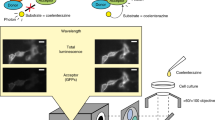Abstract
We describe here the preparation of ratiometric luminescent probes that contain two well-separated emission peaks produced by a sequential bioluminescence resonance energy transfer (BRET)-fluorescence resonance energy transfer (FRET) process. The probes are single soluble fusion proteins consisting of a thermostable firefly luciferase variant that catalyzes yellow-green (560 nm maximum) bioluminescence and a red fluorescent protein covalently labeled with a near-Infrared fluorescent dye. The two proteins are connected by a decapeptide containing a protease recognition site specific for factor Xa, thrombin, or caspase 3. The rates of protease cleavage of the fusion protein substrates were monitored by recording emission spectra and plotting the change in peak ratios over time. Detection limits of 0.41 nM for caspase 3, 1.0 nM for thrombin, and 58 nM for factor Xa were realized with a scanning fluorometer. This method successfully employs an efficient sequential BRET-FRET energy transfer process based on firefly luciferase bioluminescence to assay physiologically important protease activities and should be generally applicable to the measurement of any endoprotease lacking accessible cysteine residues.
Access this chapter
Tax calculation will be finalised at checkout
Purchases are for personal use only
Similar content being viewed by others
Abbreviations
- AF680:
-
Alexa Fluor 680 C2-maleimide
- BFFP-:
-
BRET-FRET fusion protein, a fusion protein consisting of an N-terminus hexa-His tagged mKate S158A variant joined to PpyWT-TS through the decapeptide linker GSAP4P3P2P1GSG where P4P3P2P1 is DEVD (C3), LVPR (Th), IEGR (Xa), or GSGS (GS)
- BFS-:
-
The BRET -FRET substrates corresponding to the BFFP-proteins labeled with AF680
- BRET :
-
Bioluminescence resonance energy transfer
- FRET:
-
Fluorescence resonance energy transfer
- CCD:
-
Charge-coupled device
- LC/ESMS:
-
Tandem HPLC-electrospray ionization mass spectrometry
- LH2 :
-
D-firefly luciferin
- Luc:
-
Photinus pyralis luciferase (E. C. 1.13.12.7)
- nIR:
-
Near-infrared
- PBSA buffer:
-
20 mM sodium phosphate buffer (pH 7.2) containing 150 mM NaCl, 5 mM EDTA and 0.8 M ammonium sulfate
- PpyWT:
-
Recombinant P hotinus pyralis luciferase containing the additional N-terminal peptide GPLGS
- PpyWT-TS:
-
PpyWT containing the mutations T214A, A215L, I232A, F295L, and E354K
- RFP :
-
Red fluorescent protein (mKate S158A variant)
- SRET :
-
Sequential BRET -FRET.
References
Hastings JW (1996) Chemistries and colors of bioluminescent reactions-a review. Gene 173:5–11
Widder EA (2010) Bioluminescence in the ocean: origins of biological, chemical, and ecological diversity. Science 328:704–708
Branchini BR, Behney CE, Southworth TL, Fontaine DM, Gulick AM, Vinyard DJ, Brudvig GW (2015) Experimental Support for a single electron-transfer oxidation mechanism in firefly bioluminescence. J Am Chem Soc 137:7592–7595
Carriba P, Navarro G, Ciruela F, Ferre S, Casado V, Agnati L, Cortes A, Mallol J, Fuxe K, Canela EI, Lluis C, Franco R (2008) Detection of heteromerization of more than two proteins by sequential BRET-FRET. Nat Methods 5:727–733
Branchini BR, Rosenberg JC, Ablamsky DM, Taylor KP, Southworth TL, Linder SJ (2011) Sequential bioluminescence resonance energy transfer-fluorescence resonance energy transfer-based ratiometric protease assays with fusion proteins of firefly luciferase and red fluorescent protein. Anal Biochem 414:239–245
Navarro G, McCormick PJ, Mallol J, Lluis C, Franco R, Cortes A, Casado V, Canela EI, Ferre S (2013) Detection of receptor heteromers involving dopamine receptors by the sequential BRET-FRET technology. Methods Mol Biol (Clifton, NJ) 964:95–105
Lakowicz JR (2006) Principles of fluorescence spectroscopy, 3rd edn. Springer Science + Business Media LLC, New York, NY
Chalfie M, Kain S (2006) Green fluorescent protein: properties, applications, and protocols, vol 47, 2nd edn, Methods of biochemical analysis. Wiley-Interscience, Hoboken, NJ
Tsien RY, Poenie M (1986) Fluorescence ratio imaging - a new window into intracellular ionic signaling. Trends Biochem Sci 11:450–455
Domaille DW, Zeng L, Chang CJ (2010) Visualizing ascorbate-triggered release of labile copper within living cells using a ratiometric fluorescent sensor. J Am Chem Soc 132:1194–1195
Branchini BR, Ablamsky DM, Murtiashaw MH, Uzasci L, Fraga H, Southworth TL (2007) Thermostable red and green light-producing firefly luciferase mutants for bioluminescent reporter applications. Anal Biochem 361:253–262
Neurath H (1999) Proteolytic enzymes, past and future. Proc Natl Acad Sci U S A 96:10962–10963
Branchini BR, Ablamsky DM, Rosenberg JC (2010) Chemically modified firefly luciferase is an efficient source of near-infrared light. Bioconjug Chem 21:2023–2030
Haugland RP, Spence MTZ, Johnson ID, Basey A (2005) The handbook: a guide to fluorescent probes and labeling technologies, 10th edn. Molecular Probes, Eugene, OR
Branchini BR, Southworth TL, Khattak NF, Michelini E, Roda A (2005) Red- and green-emitting firefly luciferase mutants for bioluminescent reporter applications. Anal Biochem 345:140–148
Branchini BR, Ablamsky DM, Rosenman JM, Uzasci L, Southworth TL, Zimmer M (2007) Synergistic mutations produce blue-shifted bioluminescence in firefly luciferase. Biochemistry 46:13847–13855
Chu J, Zhang ZH, Zheng Y, Yang J, Qin LS, Lu JL, Huang ZL, Zeng SQ, Luo QM (2009) A novel far-red bimolecular fluorescence complementation system that allows for efficient visualization of protein interactions under physiological conditions. Biosens Bioelectron 25:234–239
Branchini BR, Southworth TL, Murtiashaw MH, Wilkinson SR, Khattak NF, Rosenberg JC, Zimmer M (2005) Mutagenesis evidence that the partial reactions of firefly bioluminescence are catalyzed by different conformations of the luciferase C-terminal domain. Biochemistry 44:1385–1393
Acknowledgements
I gratefully acknowledge the financial support provided by the National Science Foundation (MCB 1410390), the Air Force Office of Scientific Research (FA9550-14-1-0100) and the Hans & Ella McCollum’21 Vahlteich Endowment. The technical contributions of Justin C. Rosenberg, Danielle M. Fontaine, Kelsey P. Taylor, Tara L. Southworth, and Samantha J. Linder were essential to the development of the SRET substrates.
Author information
Authors and Affiliations
Corresponding author
Editor information
Editors and Affiliations
Rights and permissions
Copyright information
© 2016 Springer Science+Business Media New York
About this protocol
Cite this protocol
Branchini, B. (2016). Firefly Luciferase-Based Sequential Bioluminescence Resonance Energy Transfer (BRET)-Fluorescence Resonance Energy Transfer (FRET) Protease Assays. In: Kim, S. (eds) Bioluminescence. Methods in Molecular Biology, vol 1461. Humana Press, New York, NY. https://doi.org/10.1007/978-1-4939-3813-1_8
Download citation
DOI: https://doi.org/10.1007/978-1-4939-3813-1_8
Published:
Publisher Name: Humana Press, New York, NY
Print ISBN: 978-1-4939-3811-7
Online ISBN: 978-1-4939-3813-1
eBook Packages: Springer Protocols




